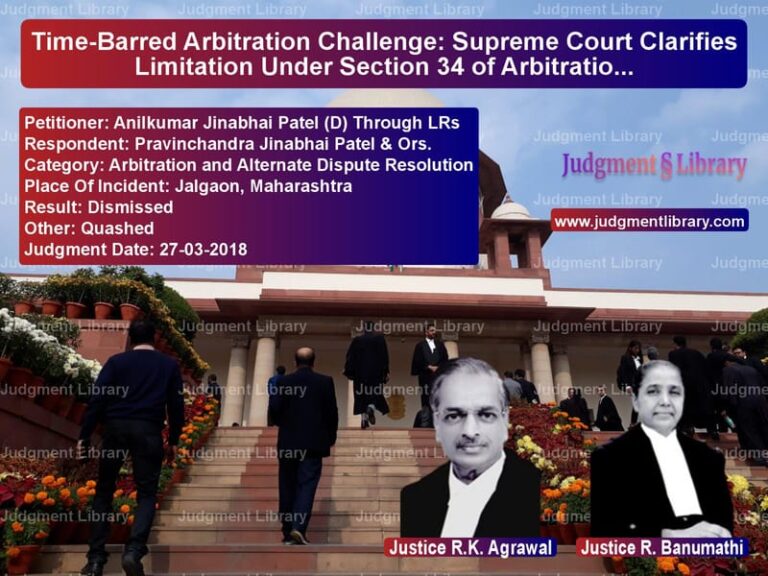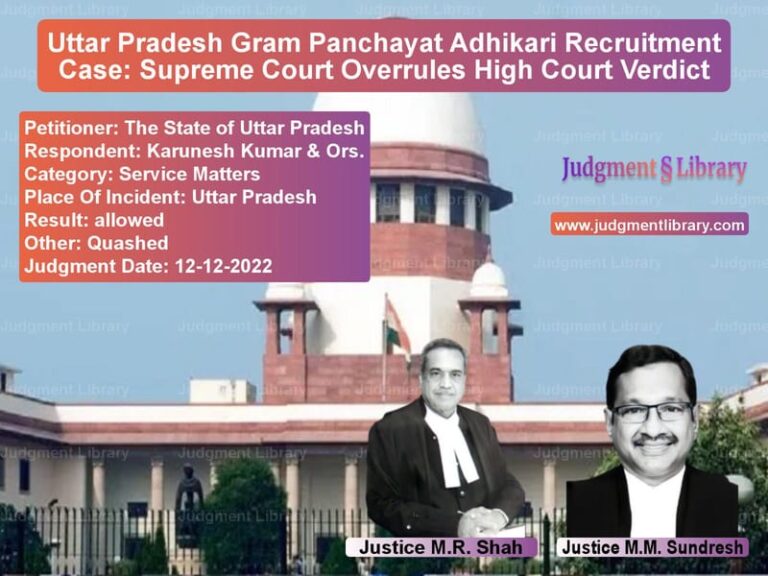Supreme Court Acquits Darshan Singh in Wife’s Murder Case Due to Lack of Evidence
The Supreme Court of India, in its judgment dated January 4, 2024, set aside the conviction of Darshan Singh, who was accused of murdering his wife, Amrik Kaur. The case, which had been based entirely on circumstantial evidence, was overturned due to inconsistencies in witness testimonies and the failure of the prosecution to establish a complete chain of events proving the appellant’s guilt beyond a reasonable doubt.
Background of the Case
The prosecution alleged that Darshan Singh and his co-accused, Rani Kaur, had an illicit relationship and conspired to eliminate Amrik Kaur. On the intervening night of May 18-19, 1999, they allegedly administered poison to the deceased, causing her death. Based on these allegations, both accused were charged under Section 302 read with Section 34 of the Indian Penal Code (IPC).
The trial court convicted both accused, sentencing them to life imprisonment. On appeal, the Punjab and Haryana High Court upheld Darshan Singh’s conviction but acquitted Rani Kaur, citing a lack of evidence against her. Darshan Singh then approached the Supreme Court, which granted him special leave to appeal.
Key Legal Issues
- Whether the prosecution had proven beyond reasonable doubt that Darshan Singh had administered poison to his wife.
- Whether the circumstantial evidence was sufficient to convict the appellant.
- Whether the High Court’s decision to acquit the co-accused, Rani Kaur, while convicting the appellant, was justified.
Petitioner’s Arguments
The appellant’s counsel argued that the conviction was based on weak circumstantial evidence. The key witness, PW-3 (Melo Kaur), had given inconsistent statements and had made several improvements in her testimony. It was contended that if her testimony was unreliable concerning Rani Kaur, it should not be relied upon against Darshan Singh either.
Additionally, the defense argued that aluminum phosphide, the alleged poison used, had a strong pungent odor, making it highly unlikely that it could be deceitfully administered without resistance. The absence of physical injuries on the deceased further suggested that she may have consumed the poison voluntarily.
The defense also pointed out that there was an alternative explanation for the death—that Amrik Kaur had committed suicide due to personal reasons. The prosecution’s failure to rule out this possibility, they argued, should entitle the appellant to the benefit of the doubt.
Respondent’s Arguments
The State of Punjab contended that the appellant had a strong motive for the crime due to his extramarital relationship with Rani Kaur. The prosecution argued that Darshan Singh’s presence in the house at the time of the incident, coupled with his failure to provide a satisfactory explanation for his wife’s death, pointed to his guilt.
Read also: https://judgmentlibrary.com/supreme-court-upholds-life-sentence-in-puducherry-murder-case/
The prosecution relied on the principle laid down in Trimukh Maroti Kirkan v. State of Maharashtra (2006) 10 SCC 681, which states that when a crime occurs inside a house where only the accused and deceased are present, the burden shifts to the accused to explain the circumstances leading to the death.
Supreme Court’s Observations
The Supreme Court analyzed the circumstantial evidence and found significant gaps in the prosecution’s case. The Court observed:
“If the evidence of PW-3 and PW-4 was not sufficient to prove the presence of Rani Kaur at the appellant’s house, as a natural corollary, such evidence cannot be relied on to conclude that the appellant was present in the house.”
Additionally, the Court noted:
“The main principle to be satisfied in a case of conviction based on circumstantial evidence is that the proved circumstances must be complete and incapable of explanation of any other hypothesis than that of the guilt of the accused but should be inconsistent with his innocence.”
The Supreme Court found that there was a strong possibility that the deceased had committed suicide. The Court cited Jaipal v. State of Haryana (2003) 1 SCC 169, where it was observed that aluminum phosphide has a distinct pungent odor, making it improbable that it could have been administered without the deceased’s knowledge.
The Court also emphasized that the prosecution had failed to prove Darshan Singh’s presence at the crime scene beyond a reasonable doubt:
“The presence of the accused at the house on the intervening night of May 18-19, 1999, is sought to be established based on unreliable witness testimony, which has been contradicted multiple times.”
Final Judgment
The Supreme Court ruled that the prosecution had failed to establish a complete chain of circumstances linking the appellant to the crime. The Court held:
“There was alive a strong hypothesis that the deceased had committed suicide, which explanation was led by the appellant in his statement under Section 313 CrPC, and it is sufficient to create a doubt in our minds.”
The Court also found the High Court’s decision to acquit Rani Kaur but convict Darshan Singh to be inconsistent:
“If the presence of Rani Kaur was not established beyond a reasonable doubt, the same logic should apply to the appellant, as the prosecution’s case rested on their alleged joint presence and conspiracy.”
Accordingly, the Supreme Court acquitted Darshan Singh and set aside his conviction.
Key Takeaways from the Judgment
- Convictions based on circumstantial evidence must meet a high standard, with no gaps in the chain of events.
- Witness testimonies containing contradictions and improvements cannot be relied upon to establish crucial facts.
- In cases where the accused is alleged to have committed a crime inside their home, the burden of proof shifts to them, but this does not absolve the prosecution from establishing a prima facie case.
- Failure to prove presence at the crime scene can be fatal to the prosecution’s case in circumstantial evidence trials.
This judgment reinforces the principle that criminal convictions must be based on concrete evidence, and mere suspicion cannot substitute for proof beyond a reasonable doubt.
Petitioner Name: Darshan Singh.Respondent Name: State of Punjab.Judgment By: Justice B. R. Gavai, Justice Pamidighantam Sri Narasimha, Justice Aravind Kumar.Place Of Incident: Punjab.Judgment Date: 04-01-2024.
Don’t miss out on the full details! Download the complete judgment in PDF format below and gain valuable insights instantly!
Download Judgment: darshan-singh-vs-state-of-punjab-supreme-court-of-india-judgment-dated-04-01-2024.pdf
Directly Download Judgment: Directly download this Judgment
See all petitions in Murder Cases
See all petitions in Fraud and Forgery
See all petitions in Judgment by B R Gavai
See all petitions in Judgment by P.S. Narasimha
See all petitions in Judgment by Aravind Kumar
See all petitions in allowed
See all petitions in Quashed
See all petitions in supreme court of India judgments January 2024
See all petitions in 2024 judgments
See all posts in Criminal Cases Category
See all allowed petitions in Criminal Cases Category
See all Dismissed petitions in Criminal Cases Category
See all partially allowed petitions in Criminal Cases Category







